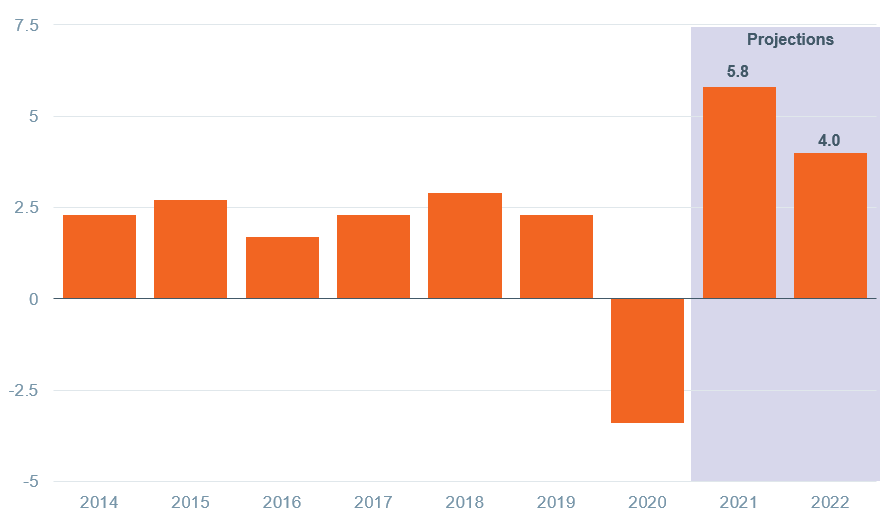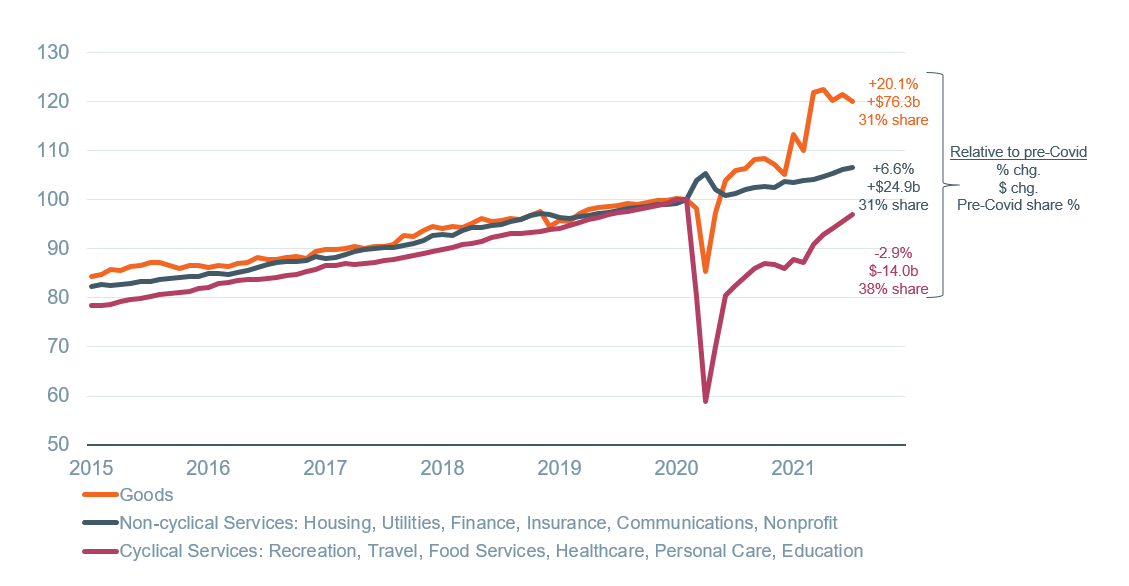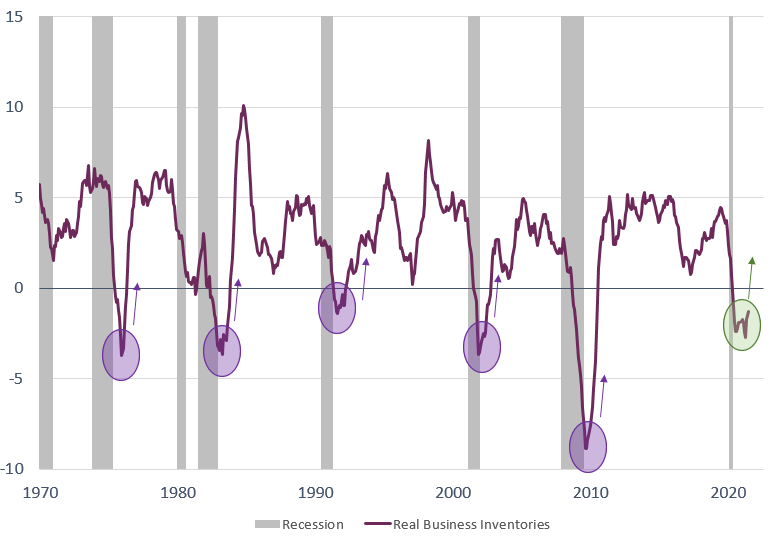 Equal Housing Lender. Bank NMLS #381076. Member FDIC.
Equal Housing Lender. Bank NMLS #381076. Member FDIC.
 Equal Housing Lender. Bank NMLS #381076. Member FDIC.
Equal Housing Lender. Bank NMLS #381076. Member FDIC.
September 20, 2021—Recent economic data have been on the weaker side and is likely playing a part in the mini-swoon we’ve seen in markets, with the S&P 500 index down about 2% from a recent all-time high in early September. The softening in data is in large part due to the spread of the Delta variant in July and August. We are reducing our outlook for the U.S. economy for the remainder of 2021 but still expect solid growth in 2022. That sturdy backdrop combined with a cautious Federal Reserve and low interest rates give us continued optimism that equities will outperform fixed income on a risk-adjusted basis and to recommend an overweight to equities relative to benchmarks in our client portfolios (for more on our positioning, see our just-published Capital Perspectives).
Economy set to decelerate but continue expansion
We are reducing our outlook for full-year real gross domestic product (GDP) growth in 2021 from 7.5% to 5.8%. That reduction comes almost entirely from a weaker consumer spending picture in the third quarter, which we describe in more detail later in this post. Despite that weakness, we expect stronger consumer growth to end the year and in 2022. We are projecting strong capital expenditures by domestic firms next year and also rebuilding of inventories. Last, we expect the bipartisan infrastructure deal, with $550 billion in new spending, and the larger, partisan spending package from the Biden administration to add to growth next year, bringing total projected growth to 4.0% in 2022.
Figure 1: Real GDP and forecast (%)

Sources: Bureau of Economic Analysis, WTIA. Data as of August 31, 2021.
Consumer spending to be weak in 3Q 2021, but resume upward trend thereafter
The most significant change to the outlook in recent months has been for the U.S. consumer which constitutes roughly two-thirds of the domestic economy. We have long expected a strong rotation this year from spending on goods—which surged under quarantine conditions and fueled by stimulus—to cyclical services such as recreation, travel, restaurants, and bars as the economy reopened. That rotation started out as expected (Figure 2) but the renewed spread of COVID-19 in the form of the Delta variant slowed spending on services in July and August, in our view.
For all of 3Q, the median forecast for consumer spending growth stood at 6.7% annualized as of the start of the quarter on July 1, but as of today is just 2.2%. Given our read of the August data thus far and the outlook for September, we would not be surprised if 3Q spending came in flat or negative.
Importantly, we expect consumer spending growth to regain momentum in 4Q and continue in 2022. We expect job growth to average 500,000–650,000 per month over the next six to nine months which would be supportive of higher spending, and consumers have a large trove of savings stashed away, too.
Figure 2: Nominal consumer spending by category (Indexed, February 2020 = 100)

Sources: Bureau of Economic Analysis, WTIA. Data as of August 31, 2021.
We define cyclical services spending as categories sensitive to the current economic cycle.
Restocking of shelves to push manufacturing
One important source of growth going forward is the restocking of inventories. Supply chain issues have driven the stock of inventoried goods well below desired levels (as anyone who has driven by a car dealership or shopped for appliances is already aware). Measured as a ratio to sales, inventories are at a decade low.
We expect restocking of inventories to keep manufacturers busy and to add substantially to economic growth over the next year. It is quite common for inventories to decline sharply during recessions (Figure 3), even if for different reasons than what has driven the decline during this current experience. There is plenty of historical precedent. In 2010, inventory growth contributed just more than half (1.4%) of the total growth of 2.7%. The experience was similar in all previous early-stage recoveries (1976, 1983, 1991, and 2002). We are projecting a similar dynamic to contribute to growth in 2022.
Figure 3: Real business inventories (%, year-over year)

Sources: Bureau of Economic Analysis, WTIA. Data as of August 31, 2021.
Keeping Congress, inflation, and the Fed in mind
Of course, no outlook for 2022 is complete without considering the still-uncertain path for fiscal and monetary policy. On the fiscal side, we expect to learn more over the next two months and adjust our outlook accordingly. It is the differential between new spending and revenue that matters most to the overall economy and there are too many moving parts at the moment. We expect Congress to enact the bipartisan infrastructure bill at the current $550 billion price tag which will add marginally to growth next year. The fate of the Biden administration’s proposed $3.5 trillion social infrastructure spending plan (and the associated tax increases) remain unclear, but we expect the spending portion to come in lower than proposed and are currently factoring in $3 trillion.
For monetary policy, we expect continued accommodation, but that the Fed will announce a reduction, or a “taper,” in the monthly rate of asset purchases at either the November or December Federal Open Market Committee (FOMC) meeting, and we don’t expect rate hikes until late 2022 at the earliest.
Core narrative
The domestic economy continues to improve but we do expect consumer spending to slow sharply and perhaps even decline in 3Q. We downgraded our expectation for full-year 2021 growth but keep a positive outlook for next year. The global economy is also on the mend with varying rates of recovery but for the most part the outlook is encouraging. The ongoing regulatory shift in China has possible implications for emerging markets returns, which we continue to evaluate. We also retain our view that equities will outperform fixed income on a risk-adjusted basis and recommend overweight positions to equities in client portfolios.
Disclosures
Facts and views presented in this report have not been reviewed by, and may not reflect information known to, professionals in other business areas of Wilmington Trust or M&T Bank who may provide or seek to provide financial services to entities referred to in this report. M&T Bank and Wilmington Trust have established information barriers between their various business groups. As a result, M&T Bank and Wilmington Trust do not disclose certain client relationships with, or compensation received from, such entities in their reports.
The information on Wilmington Wire has been obtained from sources believed to be reliable, but its accuracy and completeness are not guaranteed. The opinions, estimates, and projections constitute the judgment of Wilmington Trust and are subject to change without notice. This commentary is for informational purposes only and is not intended as an offer or solicitation for the sale of any financial product or service or a recommendation or determination that any investment strategy is suitable for a specific investor. Investors should seek financial advice regarding the suitability of any investment strategy based on the investor’s objectives, financial situation, and particular needs. Diversification does not ensure a profit or guarantee against a loss. There is no assurance that any investment strategy will succeed.
Past performance cannot guarantee future results. Investing involves risk and you may incur a profit or a loss.
Indexes are not available for direct investment.
Reference to the company names mentioned in this blog is merely for explaining the market view and should not be construed as investment advice or investment recommendations of those companies. Third party trademarks and brands are the property of their respective owners.
S&P 500 Index measures the performance of approximately 500 widely held common stocks listed on U.S. exchanges. Most of the stocks in the index are large-capitalization U.S. issues. The index accounts for roughly 75% of the total market capitalization of all U.S. equities.
Stay Informed
Subscribe
Ideas, analysis, and perspectives to help you make your next move with confidence.
What can we help you with today